Rolls-Royce Case Study: Business Management Ethics Analysis
VerifiedAdded on 2022/09/29
|13
|4263
|25
Report
AI Summary
This report analyzes the Rolls-Royce case study, focusing on ethical breaches related to bribery, corruption, and false accounting. The assignment delves into the ethical theories applicable to the case, including utilitarian, deontological, virtue, and communitarian ethics, evaluating how Rolls-Royce's actions align with or violate these principles. It examines specific remedies implemented by Rolls-Royce to address the ethical failures, such as paying fines and avoiding criminal prosecution, while still aiming to meet sales targets. Furthermore, the report proposes additional strategies and techniques, such as emphasizing justice, honesty, value-driven decision-making, transparency, and a zero-tolerance policy for ethical violations, that Rolls-Royce could adopt to improve its ethical climate and leadership. The analysis highlights the importance of ethical leadership in fostering a culture of integrity and responsible business practices, discussing how leaders should prioritize ethical decision-making and transparency to rebuild trust with stakeholders.
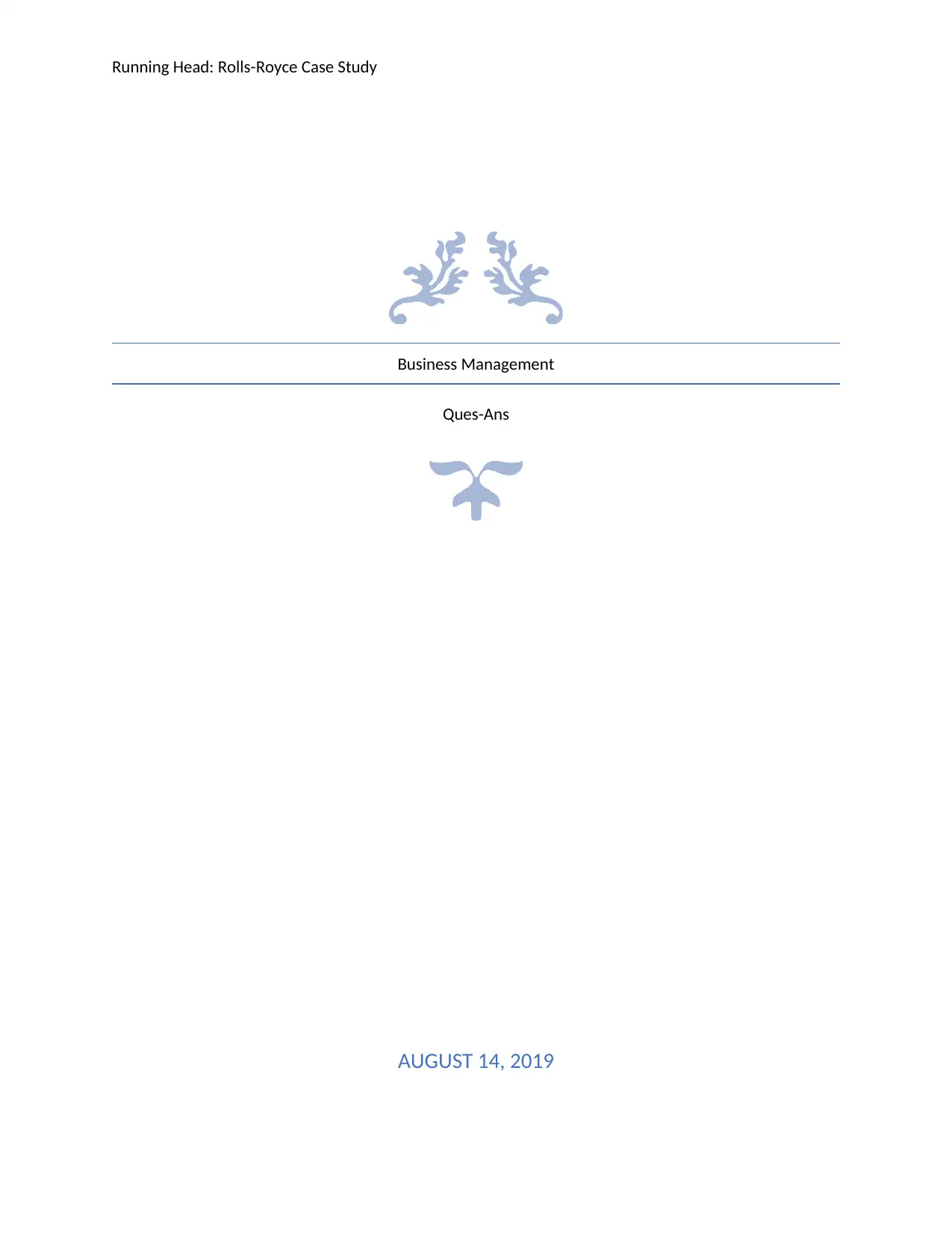
Running Head: Rolls-Royce Case Study
Business Management
Ques-Ans
AUGUST 14, 2019
Business Management
Ques-Ans
AUGUST 14, 2019
Paraphrase This Document
Need a fresh take? Get an instant paraphrase of this document with our AI Paraphraser
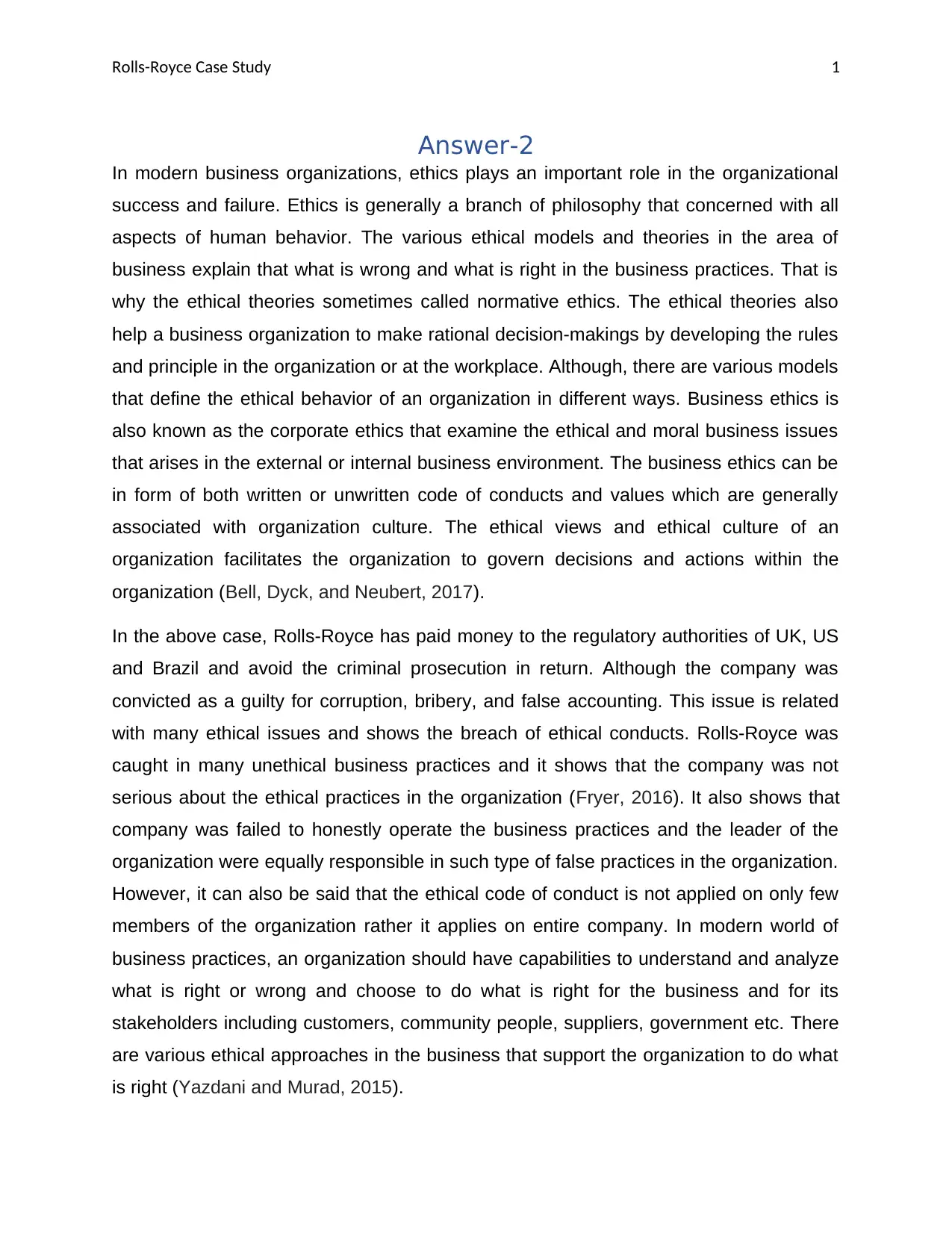
Rolls-Royce Case Study 1
Answer-2
In modern business organizations, ethics plays an important role in the organizational
success and failure. Ethics is generally a branch of philosophy that concerned with all
aspects of human behavior. The various ethical models and theories in the area of
business explain that what is wrong and what is right in the business practices. That is
why the ethical theories sometimes called normative ethics. The ethical theories also
help a business organization to make rational decision-makings by developing the rules
and principle in the organization or at the workplace. Although, there are various models
that define the ethical behavior of an organization in different ways. Business ethics is
also known as the corporate ethics that examine the ethical and moral business issues
that arises in the external or internal business environment. The business ethics can be
in form of both written or unwritten code of conducts and values which are generally
associated with organization culture. The ethical views and ethical culture of an
organization facilitates the organization to govern decisions and actions within the
organization (Bell, Dyck, and Neubert, 2017).
In the above case, Rolls-Royce has paid money to the regulatory authorities of UK, US
and Brazil and avoid the criminal prosecution in return. Although the company was
convicted as a guilty for corruption, bribery, and false accounting. This issue is related
with many ethical issues and shows the breach of ethical conducts. Rolls-Royce was
caught in many unethical business practices and it shows that the company was not
serious about the ethical practices in the organization (Fryer, 2016). It also shows that
company was failed to honestly operate the business practices and the leader of the
organization were equally responsible in such type of false practices in the organization.
However, it can also be said that the ethical code of conduct is not applied on only few
members of the organization rather it applies on entire company. In modern world of
business practices, an organization should have capabilities to understand and analyze
what is right or wrong and choose to do what is right for the business and for its
stakeholders including customers, community people, suppliers, government etc. There
are various ethical approaches in the business that support the organization to do what
is right (Yazdani and Murad, 2015).
Answer-2
In modern business organizations, ethics plays an important role in the organizational
success and failure. Ethics is generally a branch of philosophy that concerned with all
aspects of human behavior. The various ethical models and theories in the area of
business explain that what is wrong and what is right in the business practices. That is
why the ethical theories sometimes called normative ethics. The ethical theories also
help a business organization to make rational decision-makings by developing the rules
and principle in the organization or at the workplace. Although, there are various models
that define the ethical behavior of an organization in different ways. Business ethics is
also known as the corporate ethics that examine the ethical and moral business issues
that arises in the external or internal business environment. The business ethics can be
in form of both written or unwritten code of conducts and values which are generally
associated with organization culture. The ethical views and ethical culture of an
organization facilitates the organization to govern decisions and actions within the
organization (Bell, Dyck, and Neubert, 2017).
In the above case, Rolls-Royce has paid money to the regulatory authorities of UK, US
and Brazil and avoid the criminal prosecution in return. Although the company was
convicted as a guilty for corruption, bribery, and false accounting. This issue is related
with many ethical issues and shows the breach of ethical conducts. Rolls-Royce was
caught in many unethical business practices and it shows that the company was not
serious about the ethical practices in the organization (Fryer, 2016). It also shows that
company was failed to honestly operate the business practices and the leader of the
organization were equally responsible in such type of false practices in the organization.
However, it can also be said that the ethical code of conduct is not applied on only few
members of the organization rather it applies on entire company. In modern world of
business practices, an organization should have capabilities to understand and analyze
what is right or wrong and choose to do what is right for the business and for its
stakeholders including customers, community people, suppliers, government etc. There
are various ethical approaches in the business that support the organization to do what
is right (Yazdani and Murad, 2015).
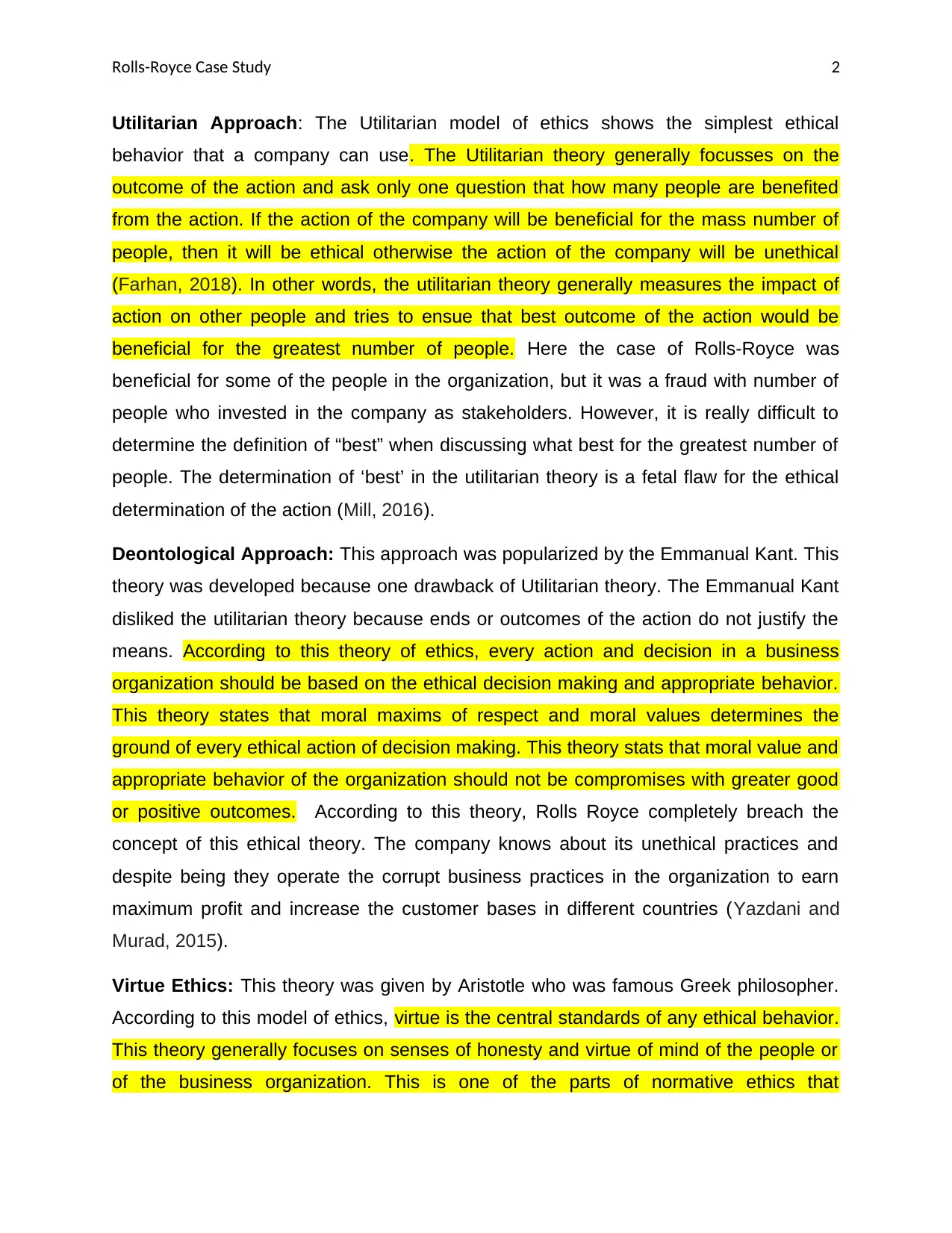
Rolls-Royce Case Study 2
Utilitarian Approach: The Utilitarian model of ethics shows the simplest ethical
behavior that a company can use. The Utilitarian theory generally focusses on the
outcome of the action and ask only one question that how many people are benefited
from the action. If the action of the company will be beneficial for the mass number of
people, then it will be ethical otherwise the action of the company will be unethical
(Farhan, 2018). In other words, the utilitarian theory generally measures the impact of
action on other people and tries to ensue that best outcome of the action would be
beneficial for the greatest number of people. Here the case of Rolls-Royce was
beneficial for some of the people in the organization, but it was a fraud with number of
people who invested in the company as stakeholders. However, it is really difficult to
determine the definition of “best” when discussing what best for the greatest number of
people. The determination of ‘best’ in the utilitarian theory is a fetal flaw for the ethical
determination of the action (Mill, 2016).
Deontological Approach: This approach was popularized by the Emmanual Kant. This
theory was developed because one drawback of Utilitarian theory. The Emmanual Kant
disliked the utilitarian theory because ends or outcomes of the action do not justify the
means. According to this theory of ethics, every action and decision in a business
organization should be based on the ethical decision making and appropriate behavior.
This theory states that moral maxims of respect and moral values determines the
ground of every ethical action of decision making. This theory stats that moral value and
appropriate behavior of the organization should not be compromises with greater good
or positive outcomes. According to this theory, Rolls Royce completely breach the
concept of this ethical theory. The company knows about its unethical practices and
despite being they operate the corrupt business practices in the organization to earn
maximum profit and increase the customer bases in different countries (Yazdani and
Murad, 2015).
Virtue Ethics: This theory was given by Aristotle who was famous Greek philosopher.
According to this model of ethics, virtue is the central standards of any ethical behavior.
This theory generally focuses on senses of honesty and virtue of mind of the people or
of the business organization. This is one of the parts of normative ethics that
Utilitarian Approach: The Utilitarian model of ethics shows the simplest ethical
behavior that a company can use. The Utilitarian theory generally focusses on the
outcome of the action and ask only one question that how many people are benefited
from the action. If the action of the company will be beneficial for the mass number of
people, then it will be ethical otherwise the action of the company will be unethical
(Farhan, 2018). In other words, the utilitarian theory generally measures the impact of
action on other people and tries to ensue that best outcome of the action would be
beneficial for the greatest number of people. Here the case of Rolls-Royce was
beneficial for some of the people in the organization, but it was a fraud with number of
people who invested in the company as stakeholders. However, it is really difficult to
determine the definition of “best” when discussing what best for the greatest number of
people. The determination of ‘best’ in the utilitarian theory is a fetal flaw for the ethical
determination of the action (Mill, 2016).
Deontological Approach: This approach was popularized by the Emmanual Kant. This
theory was developed because one drawback of Utilitarian theory. The Emmanual Kant
disliked the utilitarian theory because ends or outcomes of the action do not justify the
means. According to this theory of ethics, every action and decision in a business
organization should be based on the ethical decision making and appropriate behavior.
This theory states that moral maxims of respect and moral values determines the
ground of every ethical action of decision making. This theory stats that moral value and
appropriate behavior of the organization should not be compromises with greater good
or positive outcomes. According to this theory, Rolls Royce completely breach the
concept of this ethical theory. The company knows about its unethical practices and
despite being they operate the corrupt business practices in the organization to earn
maximum profit and increase the customer bases in different countries (Yazdani and
Murad, 2015).
Virtue Ethics: This theory was given by Aristotle who was famous Greek philosopher.
According to this model of ethics, virtue is the central standards of any ethical behavior.
This theory generally focuses on senses of honesty and virtue of mind of the people or
of the business organization. This is one of the parts of normative ethics that
⊘ This is a preview!⊘
Do you want full access?
Subscribe today to unlock all pages.

Trusted by 1+ million students worldwide
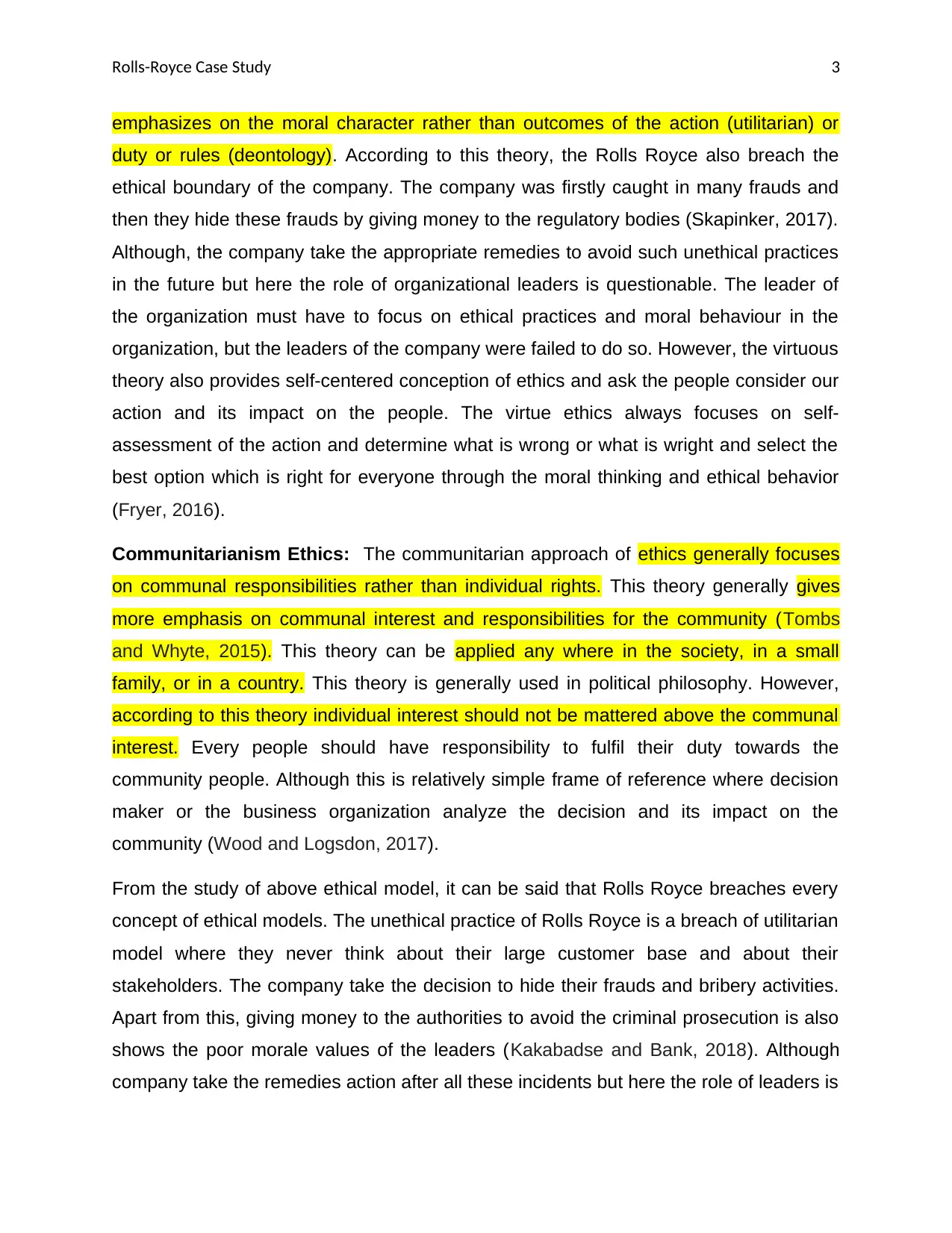
Rolls-Royce Case Study 3
emphasizes on the moral character rather than outcomes of the action (utilitarian) or
duty or rules (deontology). According to this theory, the Rolls Royce also breach the
ethical boundary of the company. The company was firstly caught in many frauds and
then they hide these frauds by giving money to the regulatory bodies (Skapinker, 2017).
Although, the company take the appropriate remedies to avoid such unethical practices
in the future but here the role of organizational leaders is questionable. The leader of
the organization must have to focus on ethical practices and moral behaviour in the
organization, but the leaders of the company were failed to do so. However, the virtuous
theory also provides self-centered conception of ethics and ask the people consider our
action and its impact on the people. The virtue ethics always focuses on self-
assessment of the action and determine what is wrong or what is wright and select the
best option which is right for everyone through the moral thinking and ethical behavior
(Fryer, 2016).
Communitarianism Ethics: The communitarian approach of ethics generally focuses
on communal responsibilities rather than individual rights. This theory generally gives
more emphasis on communal interest and responsibilities for the community (Tombs
and Whyte, 2015). This theory can be applied any where in the society, in a small
family, or in a country. This theory is generally used in political philosophy. However,
according to this theory individual interest should not be mattered above the communal
interest. Every people should have responsibility to fulfil their duty towards the
community people. Although this is relatively simple frame of reference where decision
maker or the business organization analyze the decision and its impact on the
community (Wood and Logsdon, 2017).
From the study of above ethical model, it can be said that Rolls Royce breaches every
concept of ethical models. The unethical practice of Rolls Royce is a breach of utilitarian
model where they never think about their large customer base and about their
stakeholders. The company take the decision to hide their frauds and bribery activities.
Apart from this, giving money to the authorities to avoid the criminal prosecution is also
shows the poor morale values of the leaders (Kakabadse and Bank, 2018). Although
company take the remedies action after all these incidents but here the role of leaders is
emphasizes on the moral character rather than outcomes of the action (utilitarian) or
duty or rules (deontology). According to this theory, the Rolls Royce also breach the
ethical boundary of the company. The company was firstly caught in many frauds and
then they hide these frauds by giving money to the regulatory bodies (Skapinker, 2017).
Although, the company take the appropriate remedies to avoid such unethical practices
in the future but here the role of organizational leaders is questionable. The leader of
the organization must have to focus on ethical practices and moral behaviour in the
organization, but the leaders of the company were failed to do so. However, the virtuous
theory also provides self-centered conception of ethics and ask the people consider our
action and its impact on the people. The virtue ethics always focuses on self-
assessment of the action and determine what is wrong or what is wright and select the
best option which is right for everyone through the moral thinking and ethical behavior
(Fryer, 2016).
Communitarianism Ethics: The communitarian approach of ethics generally focuses
on communal responsibilities rather than individual rights. This theory generally gives
more emphasis on communal interest and responsibilities for the community (Tombs
and Whyte, 2015). This theory can be applied any where in the society, in a small
family, or in a country. This theory is generally used in political philosophy. However,
according to this theory individual interest should not be mattered above the communal
interest. Every people should have responsibility to fulfil their duty towards the
community people. Although this is relatively simple frame of reference where decision
maker or the business organization analyze the decision and its impact on the
community (Wood and Logsdon, 2017).
From the study of above ethical model, it can be said that Rolls Royce breaches every
concept of ethical models. The unethical practice of Rolls Royce is a breach of utilitarian
model where they never think about their large customer base and about their
stakeholders. The company take the decision to hide their frauds and bribery activities.
Apart from this, giving money to the authorities to avoid the criminal prosecution is also
shows the poor morale values of the leaders (Kakabadse and Bank, 2018). Although
company take the remedies action after all these incidents but here the role of leaders is
Paraphrase This Document
Need a fresh take? Get an instant paraphrase of this document with our AI Paraphraser
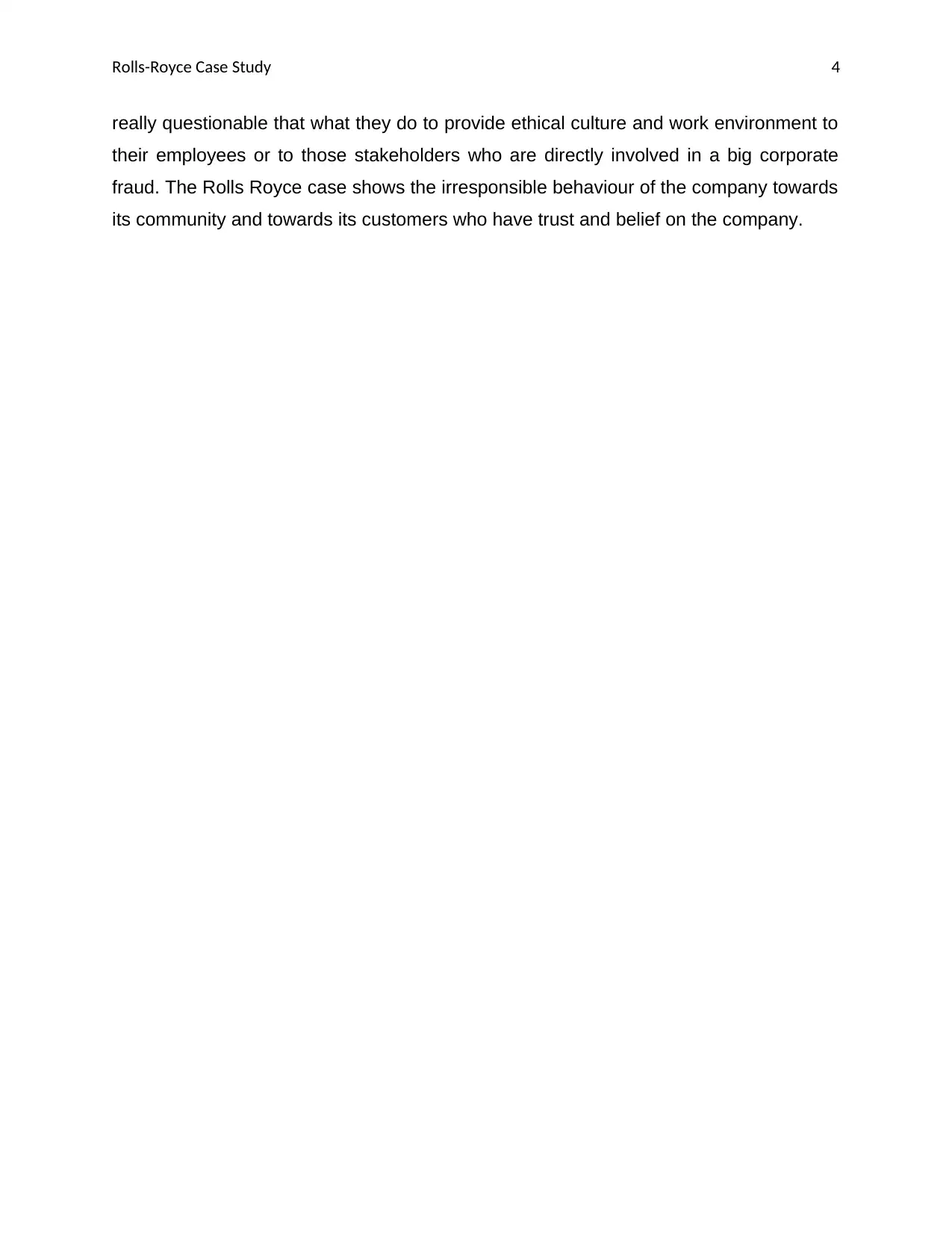
Rolls-Royce Case Study 4
really questionable that what they do to provide ethical culture and work environment to
their employees or to those stakeholders who are directly involved in a big corporate
fraud. The Rolls Royce case shows the irresponsible behaviour of the company towards
its community and towards its customers who have trust and belief on the company.
really questionable that what they do to provide ethical culture and work environment to
their employees or to those stakeholders who are directly involved in a big corporate
fraud. The Rolls Royce case shows the irresponsible behaviour of the company towards
its community and towards its customers who have trust and belief on the company.
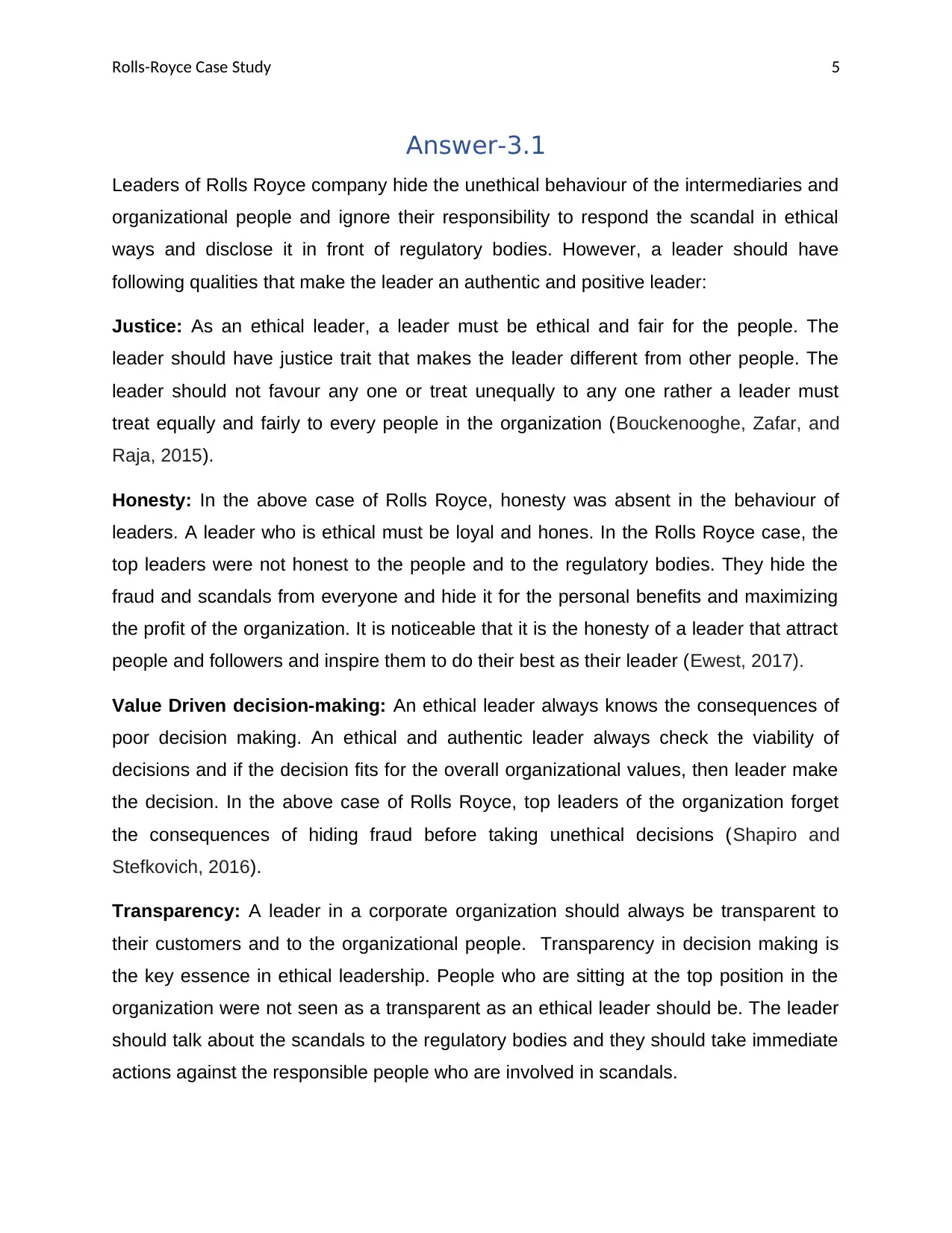
Rolls-Royce Case Study 5
Answer-3.1
Leaders of Rolls Royce company hide the unethical behaviour of the intermediaries and
organizational people and ignore their responsibility to respond the scandal in ethical
ways and disclose it in front of regulatory bodies. However, a leader should have
following qualities that make the leader an authentic and positive leader:
Justice: As an ethical leader, a leader must be ethical and fair for the people. The
leader should have justice trait that makes the leader different from other people. The
leader should not favour any one or treat unequally to any one rather a leader must
treat equally and fairly to every people in the organization (Bouckenooghe, Zafar, and
Raja, 2015).
Honesty: In the above case of Rolls Royce, honesty was absent in the behaviour of
leaders. A leader who is ethical must be loyal and hones. In the Rolls Royce case, the
top leaders were not honest to the people and to the regulatory bodies. They hide the
fraud and scandals from everyone and hide it for the personal benefits and maximizing
the profit of the organization. It is noticeable that it is the honesty of a leader that attract
people and followers and inspire them to do their best as their leader (Ewest, 2017).
Value Driven decision-making: An ethical leader always knows the consequences of
poor decision making. An ethical and authentic leader always check the viability of
decisions and if the decision fits for the overall organizational values, then leader make
the decision. In the above case of Rolls Royce, top leaders of the organization forget
the consequences of hiding fraud before taking unethical decisions (Shapiro and
Stefkovich, 2016).
Transparency: A leader in a corporate organization should always be transparent to
their customers and to the organizational people. Transparency in decision making is
the key essence in ethical leadership. People who are sitting at the top position in the
organization were not seen as a transparent as an ethical leader should be. The leader
should talk about the scandals to the regulatory bodies and they should take immediate
actions against the responsible people who are involved in scandals.
Answer-3.1
Leaders of Rolls Royce company hide the unethical behaviour of the intermediaries and
organizational people and ignore their responsibility to respond the scandal in ethical
ways and disclose it in front of regulatory bodies. However, a leader should have
following qualities that make the leader an authentic and positive leader:
Justice: As an ethical leader, a leader must be ethical and fair for the people. The
leader should have justice trait that makes the leader different from other people. The
leader should not favour any one or treat unequally to any one rather a leader must
treat equally and fairly to every people in the organization (Bouckenooghe, Zafar, and
Raja, 2015).
Honesty: In the above case of Rolls Royce, honesty was absent in the behaviour of
leaders. A leader who is ethical must be loyal and hones. In the Rolls Royce case, the
top leaders were not honest to the people and to the regulatory bodies. They hide the
fraud and scandals from everyone and hide it for the personal benefits and maximizing
the profit of the organization. It is noticeable that it is the honesty of a leader that attract
people and followers and inspire them to do their best as their leader (Ewest, 2017).
Value Driven decision-making: An ethical leader always knows the consequences of
poor decision making. An ethical and authentic leader always check the viability of
decisions and if the decision fits for the overall organizational values, then leader make
the decision. In the above case of Rolls Royce, top leaders of the organization forget
the consequences of hiding fraud before taking unethical decisions (Shapiro and
Stefkovich, 2016).
Transparency: A leader in a corporate organization should always be transparent to
their customers and to the organizational people. Transparency in decision making is
the key essence in ethical leadership. People who are sitting at the top position in the
organization were not seen as a transparent as an ethical leader should be. The leader
should talk about the scandals to the regulatory bodies and they should take immediate
actions against the responsible people who are involved in scandals.
⊘ This is a preview!⊘
Do you want full access?
Subscribe today to unlock all pages.

Trusted by 1+ million students worldwide
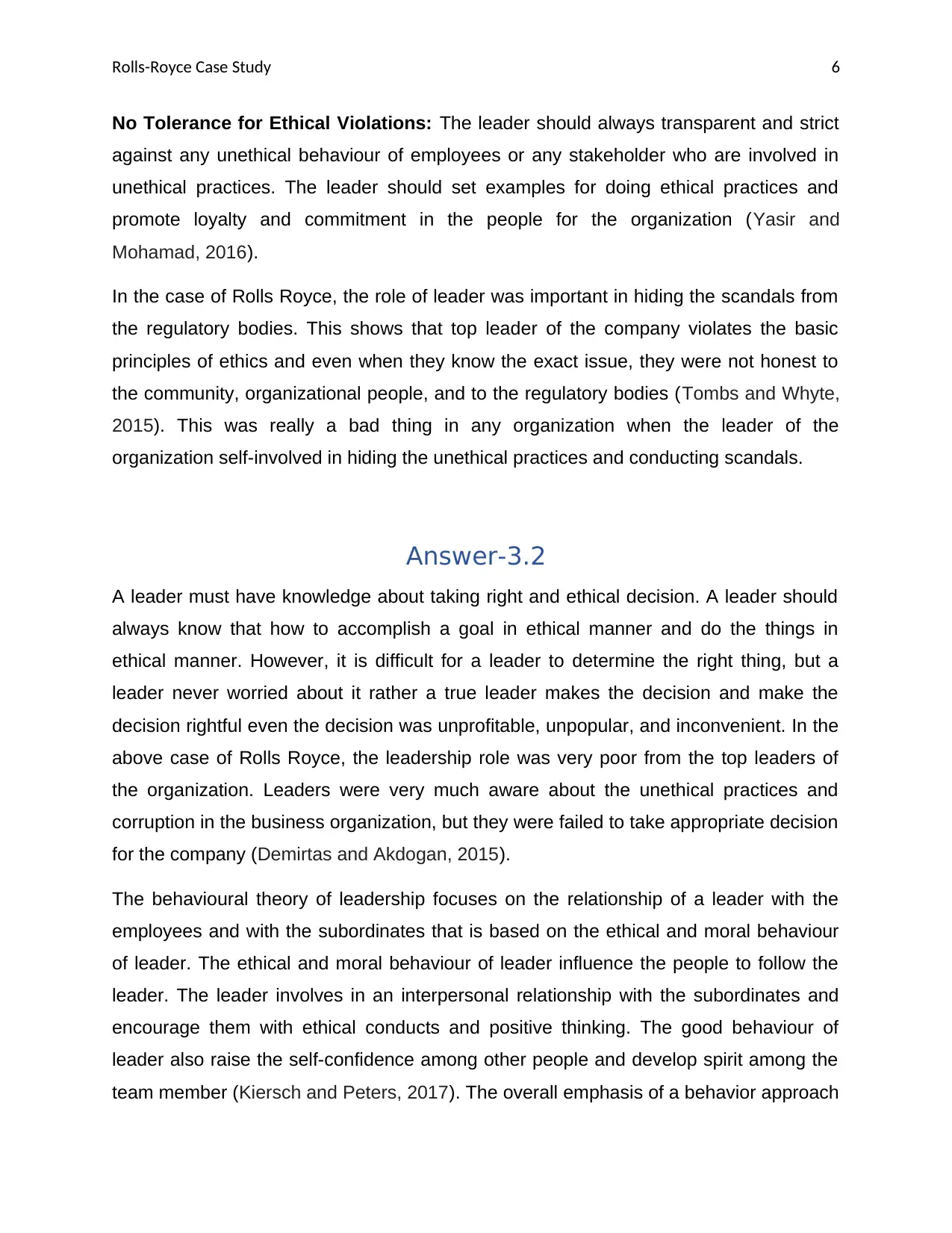
Rolls-Royce Case Study 6
No Tolerance for Ethical Violations: The leader should always transparent and strict
against any unethical behaviour of employees or any stakeholder who are involved in
unethical practices. The leader should set examples for doing ethical practices and
promote loyalty and commitment in the people for the organization (Yasir and
Mohamad, 2016).
In the case of Rolls Royce, the role of leader was important in hiding the scandals from
the regulatory bodies. This shows that top leader of the company violates the basic
principles of ethics and even when they know the exact issue, they were not honest to
the community, organizational people, and to the regulatory bodies (Tombs and Whyte,
2015). This was really a bad thing in any organization when the leader of the
organization self-involved in hiding the unethical practices and conducting scandals.
Answer-3.2
A leader must have knowledge about taking right and ethical decision. A leader should
always know that how to accomplish a goal in ethical manner and do the things in
ethical manner. However, it is difficult for a leader to determine the right thing, but a
leader never worried about it rather a true leader makes the decision and make the
decision rightful even the decision was unprofitable, unpopular, and inconvenient. In the
above case of Rolls Royce, the leadership role was very poor from the top leaders of
the organization. Leaders were very much aware about the unethical practices and
corruption in the business organization, but they were failed to take appropriate decision
for the company (Demirtas and Akdogan, 2015).
The behavioural theory of leadership focuses on the relationship of a leader with the
employees and with the subordinates that is based on the ethical and moral behaviour
of leader. The ethical and moral behaviour of leader influence the people to follow the
leader. The leader involves in an interpersonal relationship with the subordinates and
encourage them with ethical conducts and positive thinking. The good behaviour of
leader also raise the self-confidence among other people and develop spirit among the
team member (Kiersch and Peters, 2017). The overall emphasis of a behavior approach
No Tolerance for Ethical Violations: The leader should always transparent and strict
against any unethical behaviour of employees or any stakeholder who are involved in
unethical practices. The leader should set examples for doing ethical practices and
promote loyalty and commitment in the people for the organization (Yasir and
Mohamad, 2016).
In the case of Rolls Royce, the role of leader was important in hiding the scandals from
the regulatory bodies. This shows that top leader of the company violates the basic
principles of ethics and even when they know the exact issue, they were not honest to
the community, organizational people, and to the regulatory bodies (Tombs and Whyte,
2015). This was really a bad thing in any organization when the leader of the
organization self-involved in hiding the unethical practices and conducting scandals.
Answer-3.2
A leader must have knowledge about taking right and ethical decision. A leader should
always know that how to accomplish a goal in ethical manner and do the things in
ethical manner. However, it is difficult for a leader to determine the right thing, but a
leader never worried about it rather a true leader makes the decision and make the
decision rightful even the decision was unprofitable, unpopular, and inconvenient. In the
above case of Rolls Royce, the leadership role was very poor from the top leaders of
the organization. Leaders were very much aware about the unethical practices and
corruption in the business organization, but they were failed to take appropriate decision
for the company (Demirtas and Akdogan, 2015).
The behavioural theory of leadership focuses on the relationship of a leader with the
employees and with the subordinates that is based on the ethical and moral behaviour
of leader. The ethical and moral behaviour of leader influence the people to follow the
leader. The leader involves in an interpersonal relationship with the subordinates and
encourage them with ethical conducts and positive thinking. The good behaviour of
leader also raise the self-confidence among other people and develop spirit among the
team member (Kiersch and Peters, 2017). The overall emphasis of a behavior approach
Paraphrase This Document
Need a fresh take? Get an instant paraphrase of this document with our AI Paraphraser
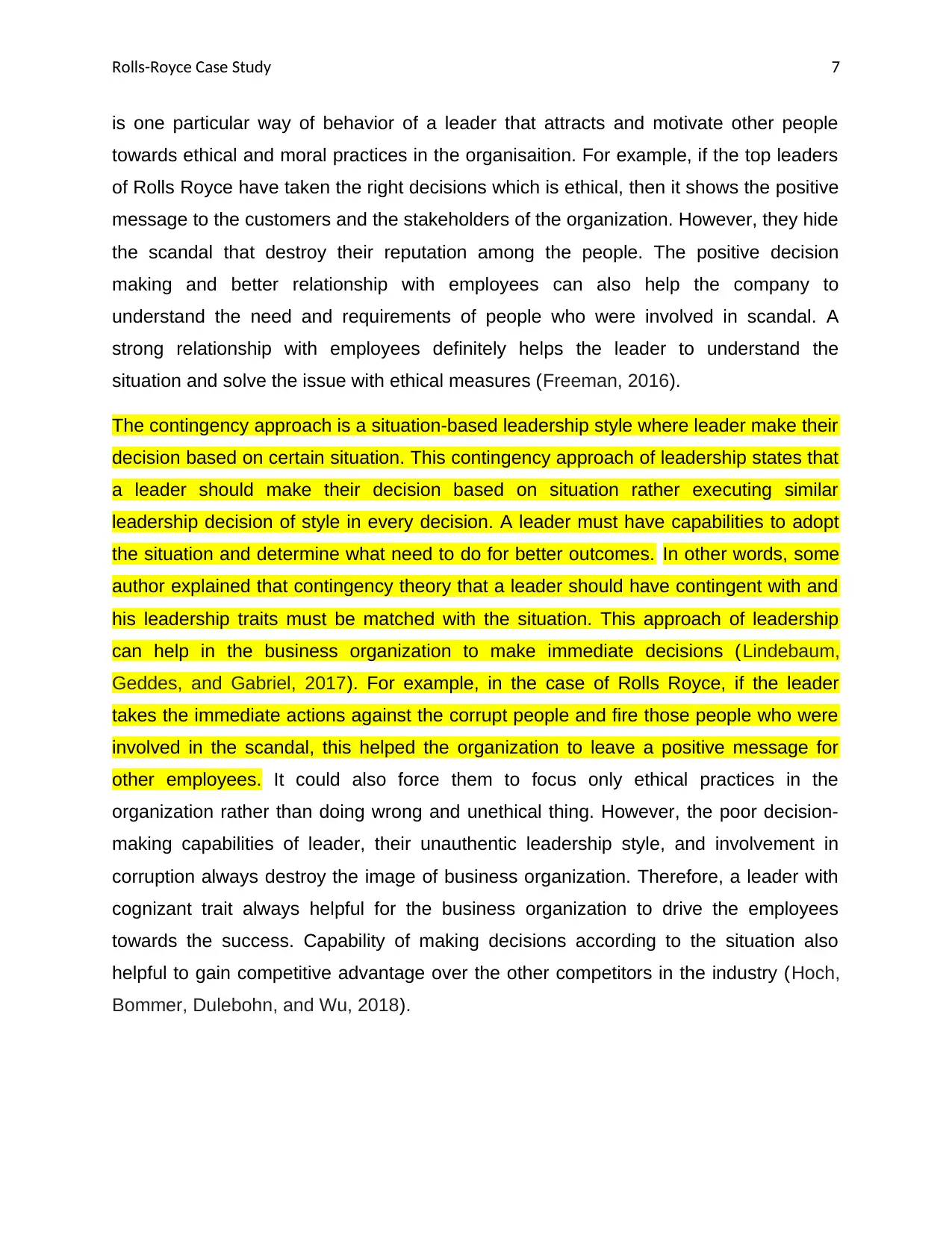
Rolls-Royce Case Study 7
is one particular way of behavior of a leader that attracts and motivate other people
towards ethical and moral practices in the organisaition. For example, if the top leaders
of Rolls Royce have taken the right decisions which is ethical, then it shows the positive
message to the customers and the stakeholders of the organization. However, they hide
the scandal that destroy their reputation among the people. The positive decision
making and better relationship with employees can also help the company to
understand the need and requirements of people who were involved in scandal. A
strong relationship with employees definitely helps the leader to understand the
situation and solve the issue with ethical measures (Freeman, 2016).
The contingency approach is a situation-based leadership style where leader make their
decision based on certain situation. This contingency approach of leadership states that
a leader should make their decision based on situation rather executing similar
leadership decision of style in every decision. A leader must have capabilities to adopt
the situation and determine what need to do for better outcomes. In other words, some
author explained that contingency theory that a leader should have contingent with and
his leadership traits must be matched with the situation. This approach of leadership
can help in the business organization to make immediate decisions (Lindebaum,
Geddes, and Gabriel, 2017). For example, in the case of Rolls Royce, if the leader
takes the immediate actions against the corrupt people and fire those people who were
involved in the scandal, this helped the organization to leave a positive message for
other employees. It could also force them to focus only ethical practices in the
organization rather than doing wrong and unethical thing. However, the poor decision-
making capabilities of leader, their unauthentic leadership style, and involvement in
corruption always destroy the image of business organization. Therefore, a leader with
cognizant trait always helpful for the business organization to drive the employees
towards the success. Capability of making decisions according to the situation also
helpful to gain competitive advantage over the other competitors in the industry (Hoch,
Bommer, Dulebohn, and Wu, 2018).
is one particular way of behavior of a leader that attracts and motivate other people
towards ethical and moral practices in the organisaition. For example, if the top leaders
of Rolls Royce have taken the right decisions which is ethical, then it shows the positive
message to the customers and the stakeholders of the organization. However, they hide
the scandal that destroy their reputation among the people. The positive decision
making and better relationship with employees can also help the company to
understand the need and requirements of people who were involved in scandal. A
strong relationship with employees definitely helps the leader to understand the
situation and solve the issue with ethical measures (Freeman, 2016).
The contingency approach is a situation-based leadership style where leader make their
decision based on certain situation. This contingency approach of leadership states that
a leader should make their decision based on situation rather executing similar
leadership decision of style in every decision. A leader must have capabilities to adopt
the situation and determine what need to do for better outcomes. In other words, some
author explained that contingency theory that a leader should have contingent with and
his leadership traits must be matched with the situation. This approach of leadership
can help in the business organization to make immediate decisions (Lindebaum,
Geddes, and Gabriel, 2017). For example, in the case of Rolls Royce, if the leader
takes the immediate actions against the corrupt people and fire those people who were
involved in the scandal, this helped the organization to leave a positive message for
other employees. It could also force them to focus only ethical practices in the
organization rather than doing wrong and unethical thing. However, the poor decision-
making capabilities of leader, their unauthentic leadership style, and involvement in
corruption always destroy the image of business organization. Therefore, a leader with
cognizant trait always helpful for the business organization to drive the employees
towards the success. Capability of making decisions according to the situation also
helpful to gain competitive advantage over the other competitors in the industry (Hoch,
Bommer, Dulebohn, and Wu, 2018).
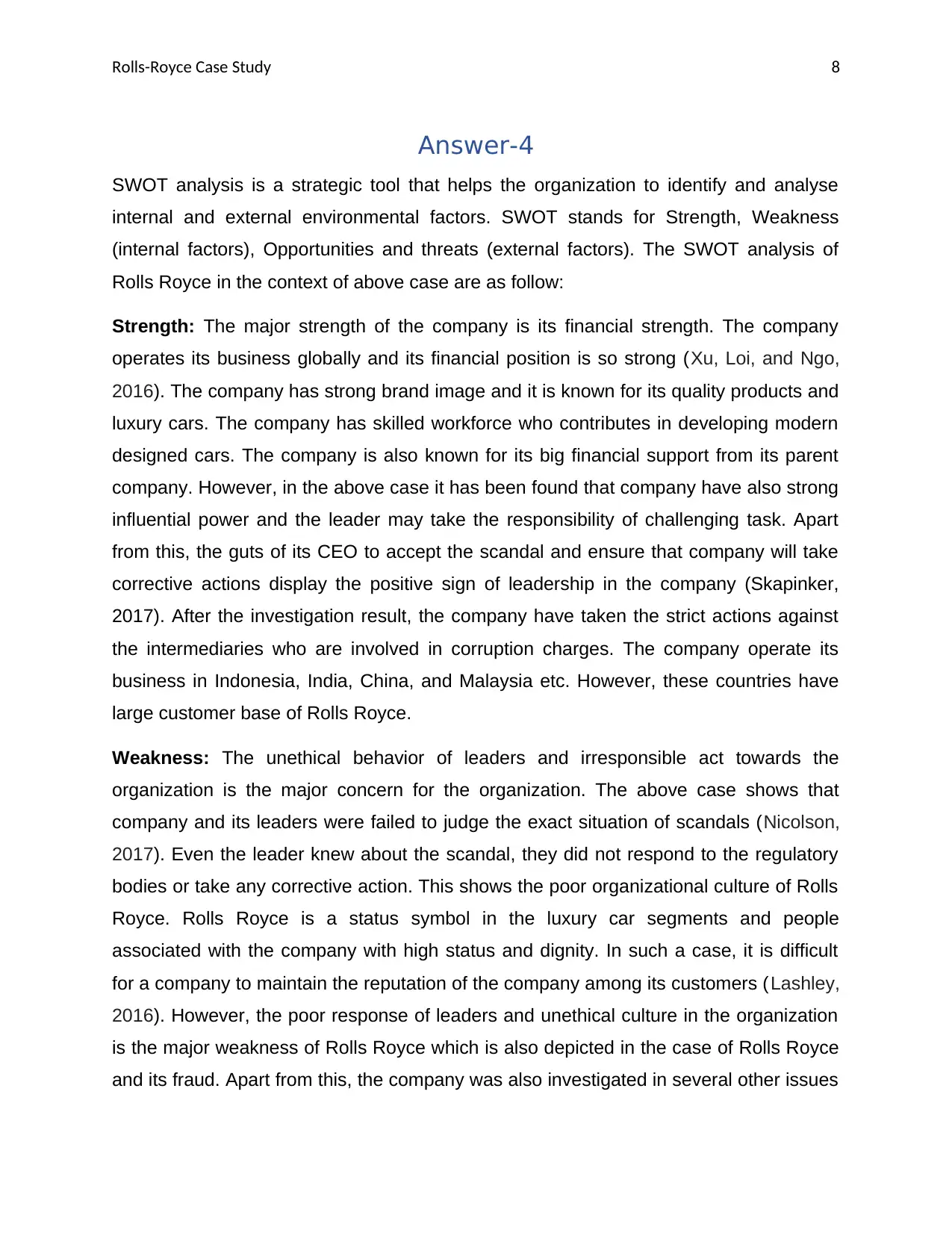
Rolls-Royce Case Study 8
Answer-4
SWOT analysis is a strategic tool that helps the organization to identify and analyse
internal and external environmental factors. SWOT stands for Strength, Weakness
(internal factors), Opportunities and threats (external factors). The SWOT analysis of
Rolls Royce in the context of above case are as follow:
Strength: The major strength of the company is its financial strength. The company
operates its business globally and its financial position is so strong (Xu, Loi, and Ngo,
2016). The company has strong brand image and it is known for its quality products and
luxury cars. The company has skilled workforce who contributes in developing modern
designed cars. The company is also known for its big financial support from its parent
company. However, in the above case it has been found that company have also strong
influential power and the leader may take the responsibility of challenging task. Apart
from this, the guts of its CEO to accept the scandal and ensure that company will take
corrective actions display the positive sign of leadership in the company (Skapinker,
2017). After the investigation result, the company have taken the strict actions against
the intermediaries who are involved in corruption charges. The company operate its
business in Indonesia, India, China, and Malaysia etc. However, these countries have
large customer base of Rolls Royce.
Weakness: The unethical behavior of leaders and irresponsible act towards the
organization is the major concern for the organization. The above case shows that
company and its leaders were failed to judge the exact situation of scandals (Nicolson,
2017). Even the leader knew about the scandal, they did not respond to the regulatory
bodies or take any corrective action. This shows the poor organizational culture of Rolls
Royce. Rolls Royce is a status symbol in the luxury car segments and people
associated with the company with high status and dignity. In such a case, it is difficult
for a company to maintain the reputation of the company among its customers (Lashley,
2016). However, the poor response of leaders and unethical culture in the organization
is the major weakness of Rolls Royce which is also depicted in the case of Rolls Royce
and its fraud. Apart from this, the company was also investigated in several other issues
Answer-4
SWOT analysis is a strategic tool that helps the organization to identify and analyse
internal and external environmental factors. SWOT stands for Strength, Weakness
(internal factors), Opportunities and threats (external factors). The SWOT analysis of
Rolls Royce in the context of above case are as follow:
Strength: The major strength of the company is its financial strength. The company
operates its business globally and its financial position is so strong (Xu, Loi, and Ngo,
2016). The company has strong brand image and it is known for its quality products and
luxury cars. The company has skilled workforce who contributes in developing modern
designed cars. The company is also known for its big financial support from its parent
company. However, in the above case it has been found that company have also strong
influential power and the leader may take the responsibility of challenging task. Apart
from this, the guts of its CEO to accept the scandal and ensure that company will take
corrective actions display the positive sign of leadership in the company (Skapinker,
2017). After the investigation result, the company have taken the strict actions against
the intermediaries who are involved in corruption charges. The company operate its
business in Indonesia, India, China, and Malaysia etc. However, these countries have
large customer base of Rolls Royce.
Weakness: The unethical behavior of leaders and irresponsible act towards the
organization is the major concern for the organization. The above case shows that
company and its leaders were failed to judge the exact situation of scandals (Nicolson,
2017). Even the leader knew about the scandal, they did not respond to the regulatory
bodies or take any corrective action. This shows the poor organizational culture of Rolls
Royce. Rolls Royce is a status symbol in the luxury car segments and people
associated with the company with high status and dignity. In such a case, it is difficult
for a company to maintain the reputation of the company among its customers (Lashley,
2016). However, the poor response of leaders and unethical culture in the organization
is the major weakness of Rolls Royce which is also depicted in the case of Rolls Royce
and its fraud. Apart from this, the company was also investigated in several other issues
⊘ This is a preview!⊘
Do you want full access?
Subscribe today to unlock all pages.

Trusted by 1+ million students worldwide
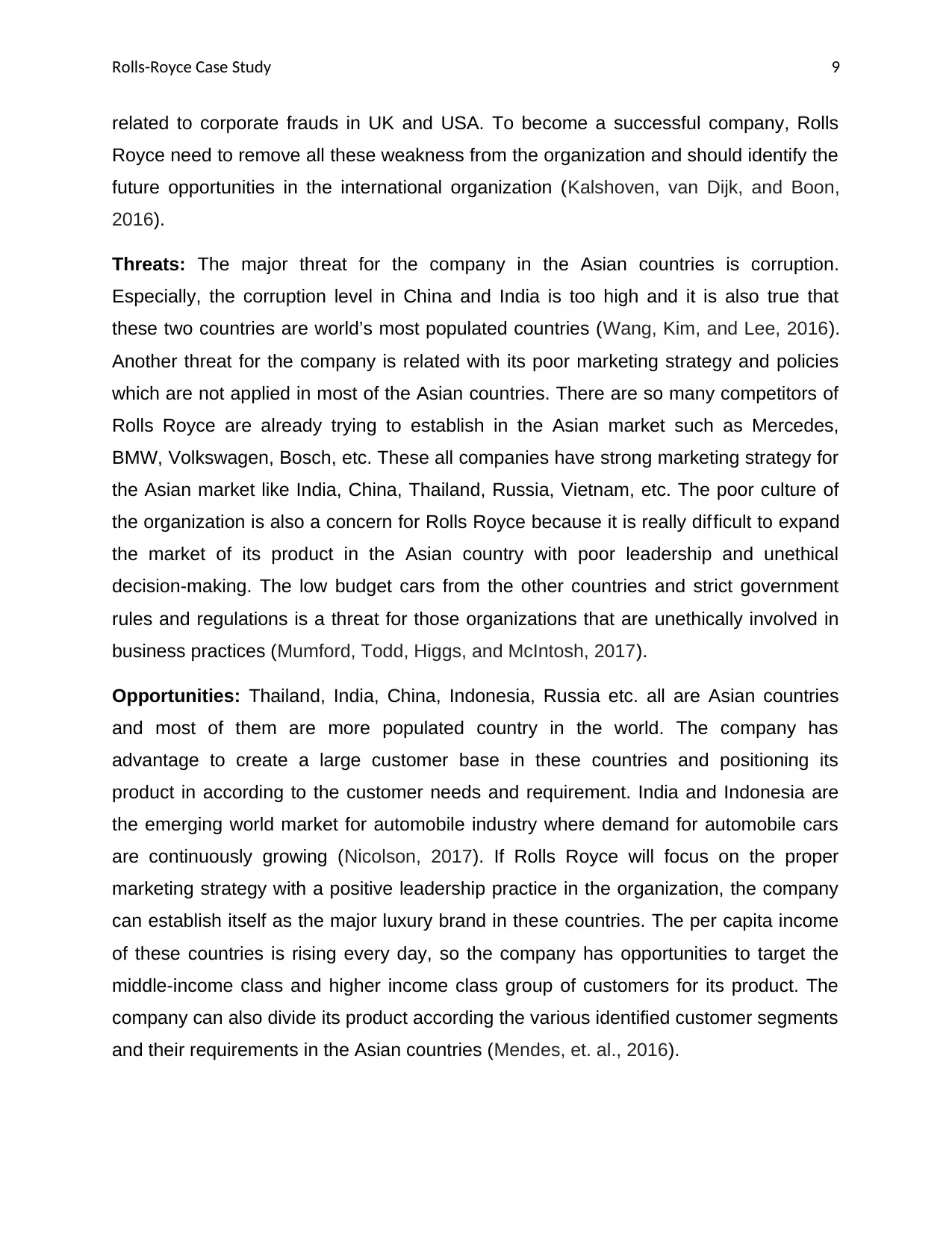
Rolls-Royce Case Study 9
related to corporate frauds in UK and USA. To become a successful company, Rolls
Royce need to remove all these weakness from the organization and should identify the
future opportunities in the international organization (Kalshoven, van Dijk, and Boon,
2016).
Threats: The major threat for the company in the Asian countries is corruption.
Especially, the corruption level in China and India is too high and it is also true that
these two countries are world’s most populated countries (Wang, Kim, and Lee, 2016).
Another threat for the company is related with its poor marketing strategy and policies
which are not applied in most of the Asian countries. There are so many competitors of
Rolls Royce are already trying to establish in the Asian market such as Mercedes,
BMW, Volkswagen, Bosch, etc. These all companies have strong marketing strategy for
the Asian market like India, China, Thailand, Russia, Vietnam, etc. The poor culture of
the organization is also a concern for Rolls Royce because it is really difficult to expand
the market of its product in the Asian country with poor leadership and unethical
decision-making. The low budget cars from the other countries and strict government
rules and regulations is a threat for those organizations that are unethically involved in
business practices (Mumford, Todd, Higgs, and McIntosh, 2017).
Opportunities: Thailand, India, China, Indonesia, Russia etc. all are Asian countries
and most of them are more populated country in the world. The company has
advantage to create a large customer base in these countries and positioning its
product in according to the customer needs and requirement. India and Indonesia are
the emerging world market for automobile industry where demand for automobile cars
are continuously growing (Nicolson, 2017). If Rolls Royce will focus on the proper
marketing strategy with a positive leadership practice in the organization, the company
can establish itself as the major luxury brand in these countries. The per capita income
of these countries is rising every day, so the company has opportunities to target the
middle-income class and higher income class group of customers for its product. The
company can also divide its product according the various identified customer segments
and their requirements in the Asian countries (Mendes, et. al., 2016).
related to corporate frauds in UK and USA. To become a successful company, Rolls
Royce need to remove all these weakness from the organization and should identify the
future opportunities in the international organization (Kalshoven, van Dijk, and Boon,
2016).
Threats: The major threat for the company in the Asian countries is corruption.
Especially, the corruption level in China and India is too high and it is also true that
these two countries are world’s most populated countries (Wang, Kim, and Lee, 2016).
Another threat for the company is related with its poor marketing strategy and policies
which are not applied in most of the Asian countries. There are so many competitors of
Rolls Royce are already trying to establish in the Asian market such as Mercedes,
BMW, Volkswagen, Bosch, etc. These all companies have strong marketing strategy for
the Asian market like India, China, Thailand, Russia, Vietnam, etc. The poor culture of
the organization is also a concern for Rolls Royce because it is really difficult to expand
the market of its product in the Asian country with poor leadership and unethical
decision-making. The low budget cars from the other countries and strict government
rules and regulations is a threat for those organizations that are unethically involved in
business practices (Mumford, Todd, Higgs, and McIntosh, 2017).
Opportunities: Thailand, India, China, Indonesia, Russia etc. all are Asian countries
and most of them are more populated country in the world. The company has
advantage to create a large customer base in these countries and positioning its
product in according to the customer needs and requirement. India and Indonesia are
the emerging world market for automobile industry where demand for automobile cars
are continuously growing (Nicolson, 2017). If Rolls Royce will focus on the proper
marketing strategy with a positive leadership practice in the organization, the company
can establish itself as the major luxury brand in these countries. The per capita income
of these countries is rising every day, so the company has opportunities to target the
middle-income class and higher income class group of customers for its product. The
company can also divide its product according the various identified customer segments
and their requirements in the Asian countries (Mendes, et. al., 2016).
Paraphrase This Document
Need a fresh take? Get an instant paraphrase of this document with our AI Paraphraser
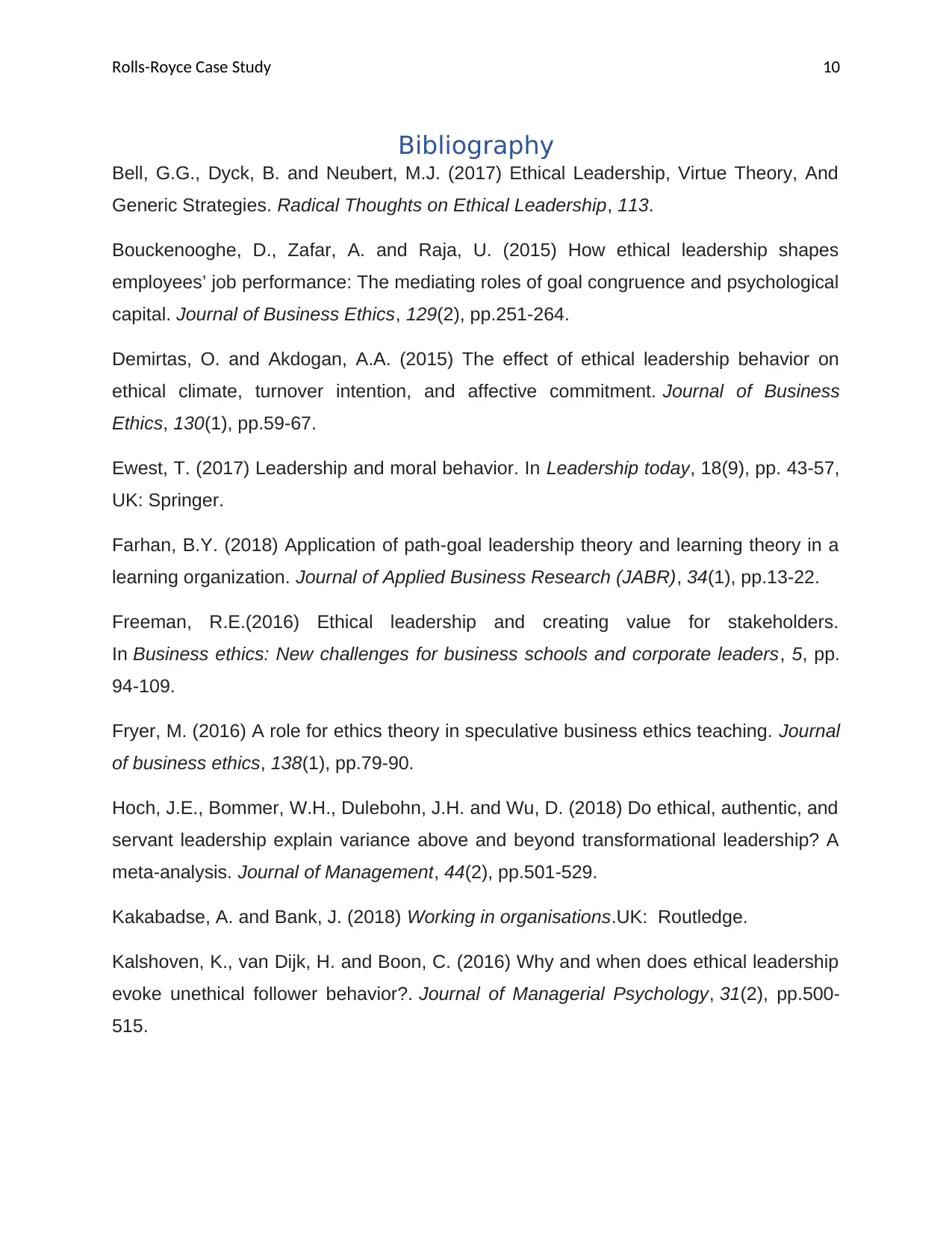
Rolls-Royce Case Study 10
Bibliography
Bell, G.G., Dyck, B. and Neubert, M.J. (2017) Ethical Leadership, Virtue Theory, And
Generic Strategies. Radical Thoughts on Ethical Leadership, 113.
Bouckenooghe, D., Zafar, A. and Raja, U. (2015) How ethical leadership shapes
employees’ job performance: The mediating roles of goal congruence and psychological
capital. Journal of Business Ethics, 129(2), pp.251-264.
Demirtas, O. and Akdogan, A.A. (2015) The effect of ethical leadership behavior on
ethical climate, turnover intention, and affective commitment. Journal of Business
Ethics, 130(1), pp.59-67.
Ewest, T. (2017) Leadership and moral behavior. In Leadership today, 18(9), pp. 43-57,
UK: Springer.
Farhan, B.Y. (2018) Application of path-goal leadership theory and learning theory in a
learning organization. Journal of Applied Business Research (JABR), 34(1), pp.13-22.
Freeman, R.E.(2016) Ethical leadership and creating value for stakeholders.
In Business ethics: New challenges for business schools and corporate leaders, 5, pp.
94-109.
Fryer, M. (2016) A role for ethics theory in speculative business ethics teaching. Journal
of business ethics, 138(1), pp.79-90.
Hoch, J.E., Bommer, W.H., Dulebohn, J.H. and Wu, D. (2018) Do ethical, authentic, and
servant leadership explain variance above and beyond transformational leadership? A
meta-analysis. Journal of Management, 44(2), pp.501-529.
Kakabadse, A. and Bank, J. (2018) Working in organisations.UK: Routledge.
Kalshoven, K., van Dijk, H. and Boon, C. (2016) Why and when does ethical leadership
evoke unethical follower behavior?. Journal of Managerial Psychology, 31(2), pp.500-
515.
Bibliography
Bell, G.G., Dyck, B. and Neubert, M.J. (2017) Ethical Leadership, Virtue Theory, And
Generic Strategies. Radical Thoughts on Ethical Leadership, 113.
Bouckenooghe, D., Zafar, A. and Raja, U. (2015) How ethical leadership shapes
employees’ job performance: The mediating roles of goal congruence and psychological
capital. Journal of Business Ethics, 129(2), pp.251-264.
Demirtas, O. and Akdogan, A.A. (2015) The effect of ethical leadership behavior on
ethical climate, turnover intention, and affective commitment. Journal of Business
Ethics, 130(1), pp.59-67.
Ewest, T. (2017) Leadership and moral behavior. In Leadership today, 18(9), pp. 43-57,
UK: Springer.
Farhan, B.Y. (2018) Application of path-goal leadership theory and learning theory in a
learning organization. Journal of Applied Business Research (JABR), 34(1), pp.13-22.
Freeman, R.E.(2016) Ethical leadership and creating value for stakeholders.
In Business ethics: New challenges for business schools and corporate leaders, 5, pp.
94-109.
Fryer, M. (2016) A role for ethics theory in speculative business ethics teaching. Journal
of business ethics, 138(1), pp.79-90.
Hoch, J.E., Bommer, W.H., Dulebohn, J.H. and Wu, D. (2018) Do ethical, authentic, and
servant leadership explain variance above and beyond transformational leadership? A
meta-analysis. Journal of Management, 44(2), pp.501-529.
Kakabadse, A. and Bank, J. (2018) Working in organisations.UK: Routledge.
Kalshoven, K., van Dijk, H. and Boon, C. (2016) Why and when does ethical leadership
evoke unethical follower behavior?. Journal of Managerial Psychology, 31(2), pp.500-
515.
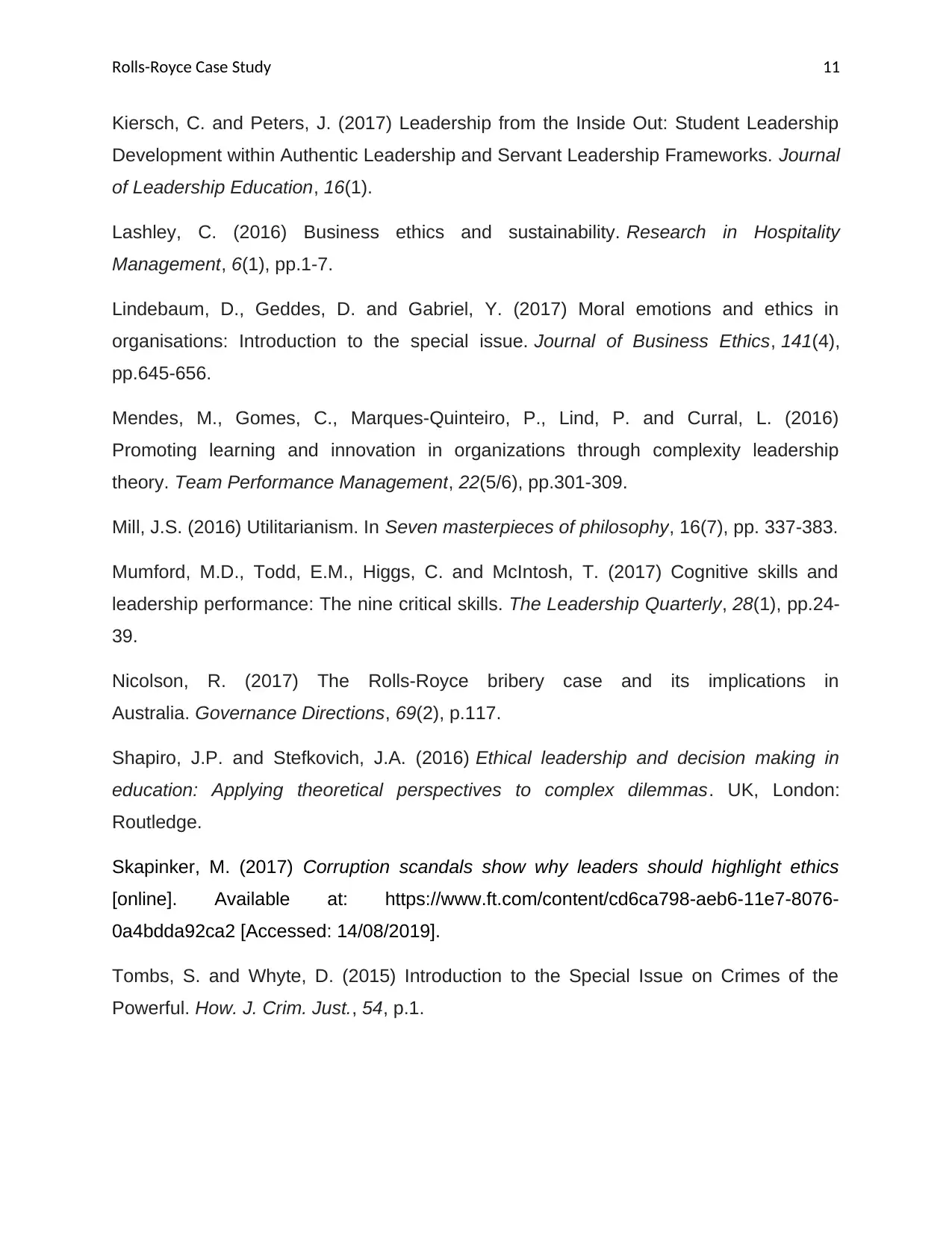
Rolls-Royce Case Study 11
Kiersch, C. and Peters, J. (2017) Leadership from the Inside Out: Student Leadership
Development within Authentic Leadership and Servant Leadership Frameworks. Journal
of Leadership Education, 16(1).
Lashley, C. (2016) Business ethics and sustainability. Research in Hospitality
Management, 6(1), pp.1-7.
Lindebaum, D., Geddes, D. and Gabriel, Y. (2017) Moral emotions and ethics in
organisations: Introduction to the special issue. Journal of Business Ethics, 141(4),
pp.645-656.
Mendes, M., Gomes, C., Marques-Quinteiro, P., Lind, P. and Curral, L. (2016)
Promoting learning and innovation in organizations through complexity leadership
theory. Team Performance Management, 22(5/6), pp.301-309.
Mill, J.S. (2016) Utilitarianism. In Seven masterpieces of philosophy, 16(7), pp. 337-383.
Mumford, M.D., Todd, E.M., Higgs, C. and McIntosh, T. (2017) Cognitive skills and
leadership performance: The nine critical skills. The Leadership Quarterly, 28(1), pp.24-
39.
Nicolson, R. (2017) The Rolls-Royce bribery case and its implications in
Australia. Governance Directions, 69(2), p.117.
Shapiro, J.P. and Stefkovich, J.A. (2016) Ethical leadership and decision making in
education: Applying theoretical perspectives to complex dilemmas. UK, London:
Routledge.
Skapinker, M. (2017) Corruption scandals show why leaders should highlight ethics
[online]. Available at: https://www.ft.com/content/cd6ca798-aeb6-11e7-8076-
0a4bdda92ca2 [Accessed: 14/08/2019].
Tombs, S. and Whyte, D. (2015) Introduction to the Special Issue on Crimes of the
Powerful. How. J. Crim. Just., 54, p.1.
Kiersch, C. and Peters, J. (2017) Leadership from the Inside Out: Student Leadership
Development within Authentic Leadership and Servant Leadership Frameworks. Journal
of Leadership Education, 16(1).
Lashley, C. (2016) Business ethics and sustainability. Research in Hospitality
Management, 6(1), pp.1-7.
Lindebaum, D., Geddes, D. and Gabriel, Y. (2017) Moral emotions and ethics in
organisations: Introduction to the special issue. Journal of Business Ethics, 141(4),
pp.645-656.
Mendes, M., Gomes, C., Marques-Quinteiro, P., Lind, P. and Curral, L. (2016)
Promoting learning and innovation in organizations through complexity leadership
theory. Team Performance Management, 22(5/6), pp.301-309.
Mill, J.S. (2016) Utilitarianism. In Seven masterpieces of philosophy, 16(7), pp. 337-383.
Mumford, M.D., Todd, E.M., Higgs, C. and McIntosh, T. (2017) Cognitive skills and
leadership performance: The nine critical skills. The Leadership Quarterly, 28(1), pp.24-
39.
Nicolson, R. (2017) The Rolls-Royce bribery case and its implications in
Australia. Governance Directions, 69(2), p.117.
Shapiro, J.P. and Stefkovich, J.A. (2016) Ethical leadership and decision making in
education: Applying theoretical perspectives to complex dilemmas. UK, London:
Routledge.
Skapinker, M. (2017) Corruption scandals show why leaders should highlight ethics
[online]. Available at: https://www.ft.com/content/cd6ca798-aeb6-11e7-8076-
0a4bdda92ca2 [Accessed: 14/08/2019].
Tombs, S. and Whyte, D. (2015) Introduction to the Special Issue on Crimes of the
Powerful. How. J. Crim. Just., 54, p.1.
⊘ This is a preview!⊘
Do you want full access?
Subscribe today to unlock all pages.

Trusted by 1+ million students worldwide
1 out of 13
Related Documents
Your All-in-One AI-Powered Toolkit for Academic Success.
+13062052269
info@desklib.com
Available 24*7 on WhatsApp / Email
![[object Object]](/_next/static/media/star-bottom.7253800d.svg)
Unlock your academic potential
Copyright © 2020–2025 A2Z Services. All Rights Reserved. Developed and managed by ZUCOL.





